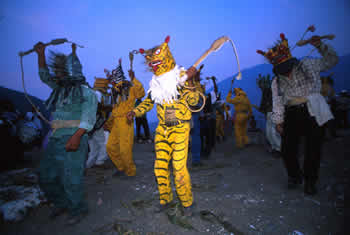Festival Highlights
 The
project has introduced me to extraordinary cultures such as the Nahua
Guerrerense who come together for the common good each year from as
far away as New York and Chicago, to experience and share pain through
The
project has introduced me to extraordinary cultures such as the Nahua
Guerrerense who come together for the common good each year from as
far away as New York and Chicago, to experience and share pain through
propitiatory dances dedicated to the rain god. These dances incorporate
pain-inflicting devices as ritual combat in the "Tigre" dances, whips in the "Tlacololero” dance,
or a wooden alligator’s bailing wire tail in the "Pescadito" dance
which is whipped around at such a high speed that it becomes invisible to the
22, paper-streamer festooned, black masked "Pescadores". These participants
must guess the tail’s trajectory in their attempt to intercept it with
their machetes, trying to cut it short enough to allow the capture of the alligator
which is greedily devouring their fish, and getting him out of their "lake" as
defined by their wide circle. This dance can last as long as five days during
which time the participants are painfully lashed by the invisible, fast-moving
bailing-wire tail, which also cuts the pescadores’ chest-high paper streamers,
thus keeping score of those working closest to the wire. Of course, these are
people who believe that they cannot ask an important favor (in this case, a
favorable rain and growing season that would result in an easier year) and
expect to have it granted without giving something personally dear in return,
which in these instances traditionally has been their pain since it is the
most expensive gift that they can afford.
Another
extraordinary find was the Huastecan carnival in an area where the
people go through the motions of an ancient
purification and renewal ritual, which was practiced during "Tlacaxipehualiztli",
the second month of the Aztec calendar, which corresponds with Mardi
Gras. This ritual was a springtime pre-planting purification ritual
during which the skin of the sacrificial victim was flayed and donned
by a priest to be removed during a ceremony a week or so later. It
was practiced during the preparation of the fields for planting in
order to remove any spiritual impediments to the proliferation of vigorous
life. Needless to say, the rite so horrified the Spanish conquistadors,
that the it was banished under the penalty of death.
The
modern Huastecan allusion to this ritual is characterized by the adding
of a skin through traditional ritualistic
body painting,using river mud as a base that is further embellished
by traditional designs painted on once the base is dry, using charcoal,
whitewash and a beautiful bright yellow pigment extracted from the
bark of the Coral tree. These layers of pigment make up an added a "skin",
which will be danced, then later "shed" during ritual bathing
in the river; leaving the celebrant to emerge renewed and purified,
much as a recently molted snake.
If
asked, the Huastecan people explain that they ritually paint their
bodies each year for seven years in
a traditional attempt to "confound the devil who is seeking out
innocent little souls among them", an explanation that I surmise
began as a "Christian" reason for the behavior, while they
exploited the gaiety of Mardi Gras as an opportunity to continue to
honor one of their own gods, "Xipe-Totec", or "Flayed-God-of-Young-Corn".
What is extraordinary is that the original reason for this cultural
behavior has apparently been forgotten, for the most part, while the
celebrants continue to mimic it.
Other
noteworthy events were the Huichol Tatei Aramara rites (The Mother
of the Ocean, syncretized with the
Virgin of Guadalupe) in front of a "caliguey" (religious
house) on a Pacific island off of the coast of Nayarit, where I accompanied
the Huichol to appropriate all of the rain for the coming year and
deal with the imbalance of natural forces that had resulted in problems
being experienced by the community, such as drought and a crop-threatening
grasshopper plague. It was a beautiful, sensitive ceremony during which
the old "marakame" (shaman) directing the rite genuinely
wept several times when describing the plight of the community and
its effect on their existence. Prayers sung between the marakame and
his 12 assistants, 6 each beautifully dressed young men and women,
lasted all night culminating at sunrise, with the sacrifice of a small
bull on a beach overlooking a white rock in the ocean, believed to
be imbued with the spirit of Tatei-Aramara. I also accompanied another
group of these fascinating people on a pilgrimage to "wirikuta" in
the San Luis Potosi desert to pick peyote. Other coups have been a
Cora Easter, the Tlapanec Akuniya (water god) festivities, and many,
many others.
![]()